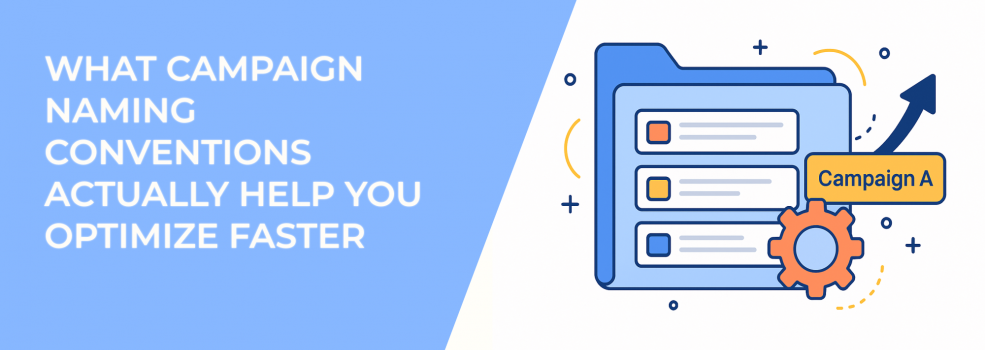If you’ve ever had to scroll endlessly through your ad account, trying to figure out which campaign is the one you should be tweaking, you know the pain of bad naming conventions.
Messy names slow you down. They make reporting harder. And they can lead to poor decisions simply because you couldn’t find the right data quickly enough.
The good news? A clean, consistent campaign naming system can shave minutes off your workflow every single day — and over the long run, that adds up to hours saved. More importantly, it helps you spot performance patterns sooner.
Here’s how to set it up so your campaigns practically organize themselves.
Why Naming Conventions Matter More Than You Think
Campaign names aren’t just labels. They’re data shortcuts. When they’re structured well, you can scan your dashboard and instantly know what’s running, who it’s targeting, and what creative it’s using — without clicking into every campaign.
Imagine you’re running 30+ campaigns across different regions, audiences, and formats. If each campaign name follows a predictable order, you can:
-
Compare similar campaigns side-by-side in seconds.
-
Filter reports by specific keywords without guesswork.
-
Hand off accounts to teammates without a “decoder” meeting.
Poor naming, on the other hand, forces you to click into each campaign to figure out its purpose. Multiply that by dozens of campaigns and your optimization time disappears fast.
The Core Structure of a High-Functioning Naming Convention
There’s no single “perfect” formula, but most effective naming systems include a combination of these elements:
-
Objective – Your campaign goal (e.g., Conversions, Traffic, Engagement).
-
Audience – The segment you’re targeting (e.g., Retargeting_30d, Lookalike_1%).
-
Placement or Platform – Where the ad is running (e.g., FB_Feed, IG_Stories, Mixed).
-
Creative Type – Video, Static, Carousel, UGC, etc.
-
Date or Version – Especially important for testing iterations.
Example format: [Objective]_[Audience]_[Placement]_[Creative]_[Version/Date]
For example, it could be Conversions_LAL1%_FBFeed_Video_V2.
The key is keeping the order consistent across all campaigns so your brain and your reporting tools both know where to look.
Your naming convention should match your campaign goal — if you’re unsure which to pick, Meta Ad Campaign Objectives Explained: How to Choose the Right One breaks down every option in plain language.
Keep It Short, but Not Cryptic
Abbreviations save space, but they can also confuse you later if they aren’t obvious. Use shorthand only if it’s clear at a glance — and ideally, document your “naming dictionary” somewhere your team can find it.
For example:
-
Good:
RT30dfor Retargeting last 30 days. -
Bad:
RTD— you’ll forget if that meant “retargeting” or “real-time data.”
When in doubt, spend the extra three seconds to type a clear word. You’ll save more time when reviewing data later.
Separate Test Campaigns Clearly
Testing is where naming conventions become mission-critical. If you’re running multiple creative tests or audience splits, label them in a way that makes winners easy to spot without digging.
Let’s say you’re testing three different headlines.
Your campaign names might look like:
-
Conversions_LAL1%_FBFeed_Video_H1. -
Conversions_LAL1%_FBFeed_Video_H2. -
Conversions_LAL1%_FBFeed_Video_H3.
At a glance, you can sort by CTR or CPA and immediately know which headline is pulling ahead.
When you’re testing creative variations, getting out of the learning phase faster helps you see results sooner — here’s how to Finish the Facebook Learning Phase Quickly without wasting budget.
Add Dates to Track Lifecycles
Dates in campaign names aren’t just for remembering launch days. They help you measure how long campaigns have been running, spot ad fatigue, and understand seasonal patterns.
Formats like 2025-08-15 (YYYY-MM-DD) keep names easy to sort chronologically.
For ongoing evergreen campaigns, a month-year format like Aug25 might be cleaner.
If your performance drops over time, it’s not always the date or name that’s the problem — learn how to spot and fix Ad Fatigue on Facebook before it hurts your results.
Don’t Ignore Filters and Search
One of the biggest hidden benefits of structured names? You can use the search bar in Ads Manager as a turbo filter. Typing “LAL1%” instantly shows all your 1% lookalike campaigns. Searching “IGStories” isolates all your Instagram Stories placements.
When every name is tagged logically, you can zoom into a subset of campaigns in seconds — no complicated report building required.
Keep Iterating Your System
Your first naming convention won’t be perfect. As your account grows, you’ll find gaps. Maybe you realize you need to add “Geo” tags because you’re expanding internationally. Or maybe you want to split “UGC” into “UGC_Testimonial” and “UGC_Demo” for clarity.
The important part is to treat naming conventions as a living system, not a one-off setup. Update your template as your strategy changes.
Final Thoughts
Campaign names might feel like a small thing, but they can make a big difference in how quickly you work. Take 30 minutes this week to look at all your campaigns. Give them clear, consistent names that include at least the goal, audience, and ad type. Write the format down so everyone on your team follows it.
Quick checklist:
-
Look through your campaign names.
-
Pick a clear format (goal → audience → placement → ad type → date/version).
-
Save that format in a shared file.
-
Rename your active campaigns to match it.
-
Use the same format for every new campaign.
A little organization now will save you time and stress later — and make Ads Manager much easier to use.

